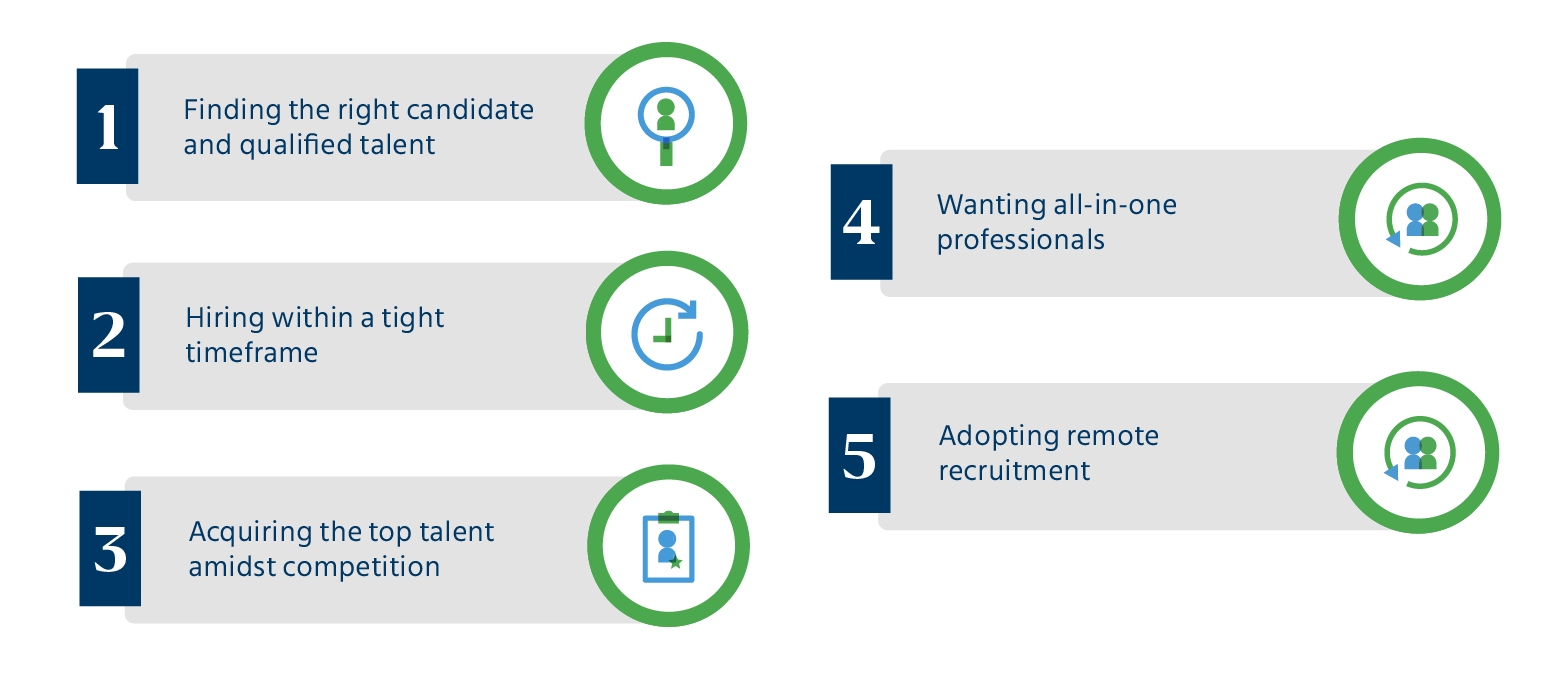Introduction
Recruitment in the technology industry is becoming more dynamic than before. Moreover, with a substantial surge in tech positions since 2020, tech hiring challenges have increased considerably. As a result, the global tech talent war is at its peak. On the one hand, acquiring new talent is a challenge and on the other, retaining the existing tech force is a pressing concern for businesses worldwide. This blog elaborates on these hiring challenges and offers solutions to overcome them.
Why is recruitment complicated in the tech industry?
According to a Cyberstates report, there are nearly 507,000 tech organizations in the U.S. alone, with an expected increase of 5% every year in the coming years.
The number of tech establishments that require skills such as the development of apps and websites, advanced coding skills and in-depth knowledge of technologies such as artificial intelligence (AI) and cyber security is consistently increasing. As a result, the number of openings in those organizations is also on the rise.
According to the study published by Cyberstates, nearly 3.6 million jobs were posted by U.S. employers alone in 2021. So, you can imagine the number of openings posted by recruiters worldwide. That reinstates that the demand for tech talent is incredibly high. Moreover, there are huge expectations from candidates.
- Top talent and qualified candidates are thinking about employment benefits that go beyond financial compensation. Hence, recruiters must consider strategies to complement the pay scale that attracts suitable candidates.
- The tech industry is constantly changing and candidates must upgrade their skills with the advent of new and updated technologies. So, finding the right candidate with extensive and upgraded skillsets intensifies the tech hiring challenges.
- The absence of available experts in the industry shifts the onus of technical L&D (learning and development) to employers. As a result, businesses need to strategize their talent management approach focusing on succession planning and sustainable employee engagement.
Many companies are trying to solve their recruitment issues by implementing different strategies that involve hiring more freelancers and fewer full-time employees. They are trying to get the job done instead of training and re-skilling their employees, who may leave at any time with attractive offers standing in their mailboxes. Such trends are introducing new complications in the job market. Let us look at a few of them in detail.

Top five tech hiring challenges and how to overcome them
Although technology is often touted as the solution to everything, innovation is a problem that can't be solved with a new software update or product release. Rather, it will require recruiting departments to think outside the box and companies to consider talent pools they may have previously ignored.
How to fix the broker recruiting process in the tech industry
McShane, Ian Forbes Technology Council


1. Finding the right candidate and qualified talent
Many professionals are updating their skills and learning about new technologies. But it is challenging to find them. In addition, recruiters observe candidate shortcomings in experience, soft skills, and educational qualifications.
Solution
Recruiters must find self-taught professionals and lower the expectations regarding academic affiliation. Self-taught developers are willing to learn about technological updates and take on new challenges in the changing tech world.
- Many tech professionals do not have fancy degrees but have excellent technical and analytical skills. Employers can train them and utilize their skills to get the job done.
- Coding contests, referrals and social media recruiting can help expand tech talent outreach.
- Precise job descriptions are vital to attracting suitable candidates as they communicate the appreciation for their skills and expertise.

2. Hiring within a tight timeframe
Tech hiring may be an extended process as hiring managers must test candidates for different skills. Moreover, various functions such as background checks, salary negotiations and other non-technical tasks need time. From generating a job opening to hiring, the timeframe is long. Many recruiters believe that taking time and evaluating candidates on every level is essential to ensure efficiency and a good return on investment. However, candidates are more likely to drop from recruiting processes that involve too many rounds.
Solution
In a candidate-driven job market, recruiters need to accelerate each process involved in technical screening. From finding suitable candidates to negotiating the pay scale, every stage is vital and needs to be accelerated.
Finding the right candidates through keywords on job posting sites, conducting online tests and interviews, creating a pool of applicants, and choosing the candidates as soon as possible through an efficient negotiation strategy are significant ways to accelerate the process. In addition, recruiters can take the help of technologically-advanced tools and software to manage the recruitment process.

3. Acquiring the top talent amidst competition
Based on Bain’s analysis of Glassdoor ratings of tech companies, three factors are emerging as strong influences on where the most talented candidates want to work: 1. Commitment to diversity and inclusion 2. Transparent and accountable senior management 3. Culture of coaching and development
How to attract top tech talent,
Frick, Jonathan Harvard Business Review
As established throughout this blog, the demand for top talent is enormous. Therefore, tech companies utilize every innovative strategy to overcome their recruitment woes. Among the most efficient approaches are offering high pay packages with benefits, building a powerful employer brand, investing in candidate experience, employee engagement, etc. At the same time, it keeps getting more difficult to keep up with the competition, especially for startups and smaller players in the industry.
Solution
Employers need to create a positive brand that candidates are willing to join. From showcasing the work culture to growth scenarios, companies can attract top talent and battle challenges in hiring employees. They can utilize social media and websites to showcase the positive image, and ask employees to post reviews on sites like Glassdoor.
Companies must also offer flexible working hours, remote options, insurance, a favorable leave policy, and other benefits that make them stand out. Also, asking existing employees to bring top talent from their network can add to the talent pool.

4. Wanting all-in-one professionals
One of the major recruitment issues faced in the tech industry is the need for an all-in-one professional. From specialized coding to project management skills, extensive experience and solid academic background, many companies set high expectations for tech professionals. But unfortunately, many companies do not realize that all-in-one professionals also demand high salaries and perks. And they are not willing to match the expectations mentioned earlier.
Solution
Recruiters and businesses must reduce their unrealistic expectations and eliminate the idea of the perfect recruit. Instead, recruiters can determine the problems to solve and create practical candidate personas. Doing so will ease the talent search and get the right professional on board.
Furthermore, while creating job descriptions, it is vital to mention the must-have and nice-to-have skills separately so that candidates can clearly understand before applying. As a result, the recruitment team will know the exact skills to look after and bring in the right candidates. That, in turn, accelerates the hiring process.
Also, read
A much-awaited tell-all report offering unparalleled insights into global tech hiring trends.
Mercer | Mettl’s Tech skills and trends report 2022

5. Adopting remote recruitment
Companies may not always find the required candidate locally. However, the qualified candidate may work on the other side of the world. Many candidates are willing to take up jobs across foreign locations for a better pay scale, overcome communication barriers and experience different working cultures. However, the recruiting team may lack the skills and exposure to find and connect with talent globally. Hiring challenges are rising as many companies are unwilling to adapt to remote work despite knowing that talent from many countries is cheaper than the local market. However, there is no remote recruitment strategy in place.
Solution
Adopting a powerful remote recruitment strategy is vital, including training the HR (Human Resources) team to find and approach candidates to streamline the interview process. In addition, conducting online technical skills assessments to determine their technical expertise, carrying out psychometric tests to know about their personality, and scheduling video interviews to assess how candidates interact is crucial.
How Mercer | Mettl can help
Mercer | Mettl helps organizations build winning teams using state-of-the-art assessments and talent evaluation platforms.. It helps companies conduct online coding assessments and tests per the specific requirements, conduct online hackathons to find talent and carry out psychometric tests to assess the candidates’ personalities. These processes help companies accelerate hiring via automation. In addition, Mercer | Mettl platforms help find the gaps in current skills requirements and employees’ existing skills, thereby fueling streamlined employee training initiatives.
FAQs
What are the best ways to find tech talent?
What to look for in a CV while hiring a tech candidate?
Should I prefer tech graduates while recruiting?
How to lure passive candidates into joining our organization?
Originally published October 17 2022, Updated October 18 2022
About This Topic
Hiring a coder requires HRs to go beyond conventional hiring practices and assess the candidate on both knowledge and hands-on skills. A holistic suite of assessments and simulators, used in conjunction, can simplify the technical hiring process and better evaluate programmers and developers.
Related Topics:
![]()